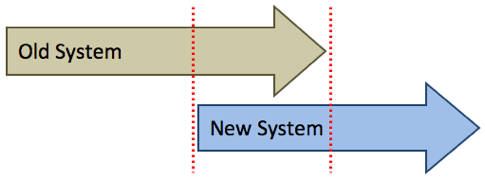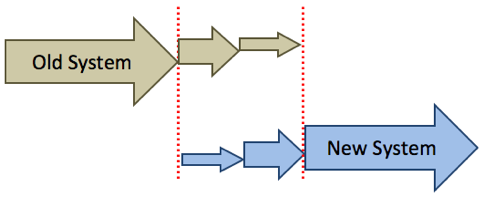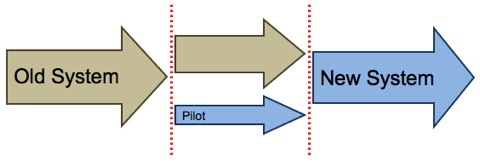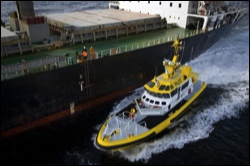The implementation of the new system occurs when the old system is replaced by the new one.
There are a new of ways of implementing a new system...
There are a new of ways of implementing a new system...
Documentation
Implementation
Evaluation
Direct Changeover
The old system is stopped completely, and the new system is started. All of the data that used to be input into the old system, now goes into the new one.

This is has its advantages...
- Takes the minimal time and effort
- The new system is up and running immediately
- If the new system fails, there is no back-up system, so data can be lost

Sometimes a direct changeover is the only way to implement a new system.
E.g. an aircraft's auto-pilot system can't have a new and old version running side-by-side, arguing about what to do!
E.g. an aircraft's auto-pilot system can't have a new and old version running side-by-side, arguing about what to do!
Parallel Running
The new system is started, but the old system is kept running in parallel (side-by-side) for a while. All of the data that is input into the old system, is also input into the new one.
Eventually, the old system will be stopped, but only when the new system has been proven to work.
Eventually, the old system will be stopped, but only when the new system has been proven to work.

This is has its advantages...
- If anything goes wrong with the new system, the old system will act as a back-up.
- The outputs from the old and new systems can be compared to check that the new system is running correctly
- Entering data into two systems, and running two systems together, takes a lot of extra time and effort

Phased Implementation
The new system is introduced in phases (stages, or steps), gradually replacing parts of the old system until eventually, the new system has taken over.

This is has its advantages...
- Allows users to gradually get used to the new system
- Staff training can be done in stages
- If a part of the new system fails, there is no back-up system, so data can be lost

Pilot Running
The new system is first of all piloted (trialled) in one part of the business / organisation (e.g. in just one office, or in just one department).
Once the pilot system is running successfully, the new system is introduced to the all of the business / organisation.
Once the pilot system is running successfully, the new system is introduced to the all of the business / organisation.

This is has its advantages...
- All features of the new system can be fully trialled
- If something goes wrong with the new system, only a small part of the organisation is affected
- The staff who were part of the pilot scheme can help train other staff.
- For the office / department doing the pilot, there is no back-up system if things go wrong

A 'pilot' is someone who guides others - someone who leads the way.
On an airplane, the pilot guides all of the passengers safely to their destination.
In a port, the pilot is a person on a small boat who guides large ships safely into the harbour.
On an airplane, the pilot guides all of the passengers safely to their destination.
In a port, the pilot is a person on a small boat who guides large ships safely into the harbour.
